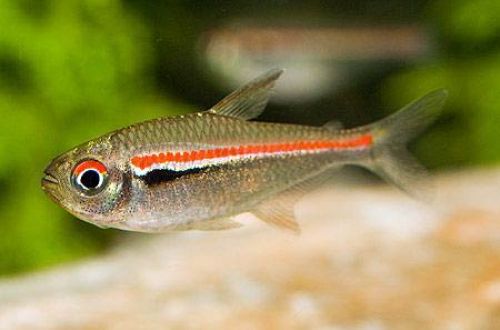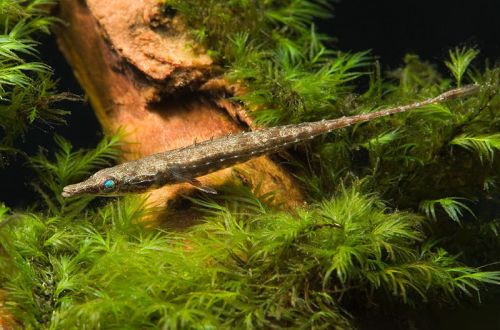
Three line tetra
The trilinear tetra, scientific name Hyphessobrycon heterorhabdus, belongs to the Characidae family. A miniature tetra, despite its size, it needs a spacious aquarium to fully satisfy their swimming needs. Otherwise, this is a simple and unpretentious fish that will be an excellent choice even for a novice aquarist.

Contents
Habitat
It comes from South America from the territory of the eastern states of Brazil – Para and Maranhao. Inhabits the basins of the Tocantins and Xingu rivers, as well as many other rivers flowing along the eastern Brazilian coast into the Atlantic Ocean. It is found in small streams flowing through tropical rainforest. The natural habitat is not subject to seasonal changes, as happens in the Amazon (rainy and dry seasons). The channel is shaded by tree crowns and coastal vegetation. The water is clean and transparent, the substrates are sandy, the bottom is covered with a layer of fallen branches and leaves. Aquatic plants are usually absent.
Brief information:
- The volume of the aquarium – from 70 liters.
- Temperature – 20-26°C
- Value pH — 5.5–7.5
- Water hardness – soft (2-12 dGH)
- Substrate type – any dark
- Lighting – subdued
- Brackish water – no
- Water movement is weak
- The size of the fish is about 3 cm.
- Feeding – any food of suitable size
- Temperament – peaceful
- Keeping in a flock of at least 8-10 individuals
Description
Adults reach a length of about 3 cm. Males look slimmer than females, which are noticeably larger. The body color is dark with a gray back and a silvery belly. A distinctive feature of the species is a tricolor stripe stretching from head to tail along the body. The stripe includes black, yellowish and reddish lines. The flag of Belgium has a similar coloring, which is why this fish is sometimes called Tetra “Belgian Flag”.
Food
In nature, it feeds on everything that can fit in its tiny mouth. These are small invertebrates, crustaceans, filamentous algae, fruits that have fallen into the water, plant seeds and other products. The home aquarium will accept most popular foods in the aquarium trade of a suitable size in the form of flakes, pellets, frozen or live brine shrimp, bloodworms, daphnia, etc.
Maintenance and care, arrangement of the aquarium
The optimal size of the aquarium for a flock of 8-10 fish starts from 70-80 liters. It is desirable that the design resembles the natural habitat of the Trilinear tetras. The main condition is the presence of a large free space for swimming and several shelters on the sides of the tank. As the latter, strongly branching natural snags are perfect. Live aquatic plants are not required. When using them, excessive growth should not be allowed.
A useful addition will be the leaves of some trees placed on the bottom, they will not only give more naturalness to the design, but also have a positive effect on the composition of the water, acidifying it. When decomposed, the leaves release tannins and other tannins, thereby repeating the process that occurs in nature. More details in a separate article “The leaves of which trees can be used in an aquarium.”
In general, the maintenance of an aquarium with Tetra “Belgian Flag” is standard. To maintain a stable aquatic environment, weekly replacement of part of the water with fresh water (15-20% of the volume), which can be combined with cleaning the soil with a siphon, and regular maintenance of the installed equipment will be required.
Behavior and Compatibility
Its peaceful disposition makes it an excellent candidate for a community of other freshwater fish of comparable size, provided there are no aggressive or territorial species among them. It is recommended to purchase tetras in a group of at least 8-10 individuals, the more, the better. When kept alone, they will become unnecessarily shy.
Breeding / breeding
Cases of the appearance of fry are not rare, breeding is possible even for novice aquarists. In acclimatized fish in a home aquarium, the breeding season is not pronounced. Sometimes, the fact that spawning has occurred can only be recognized by the fry that have appeared, and then if they do not have time to eat.
The breeding strategy of the Trilineated Tetra is simple – they randomly spawn without forming a clutch. Parental instincts are not developed, therefore, from the moment of fertilization, the eggs become left to themselves. The newly hatched fry should be transferred to a separate tank with identical water conditions. Feeding such tiny creatures can cause some difficulty in finding the right food. If leaves are used in the aquarium, it is likely that a colony of microorganisms, such as shoe ciliates, has formed during decomposition. In this case, bottom water is poured into the tank with juveniles and a portion of leaves is placed. However, you should not rely on a colony of ciliates and purchase special nutrient suspensions for fry.
Fish diseases
A balanced aquarium biosystem with suitable conditions is the best guarantee against the occurrence of any disease. If the fish’s behavior, color has changed, non-characteristic spots and other symptoms have appeared, the first thing to do is to check the water parameters, and only then proceed to treatment. Read more about symptoms and treatments in the Aquarium Fish Diseases section.





